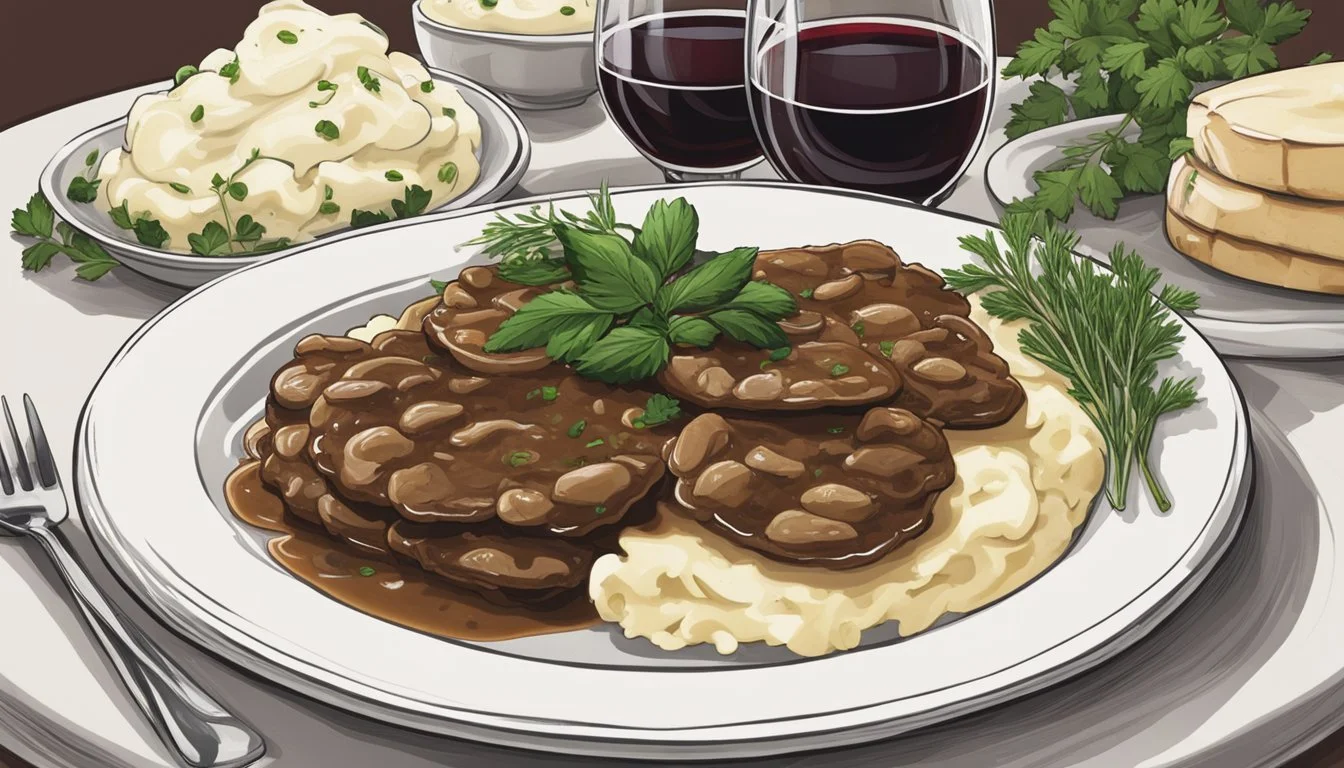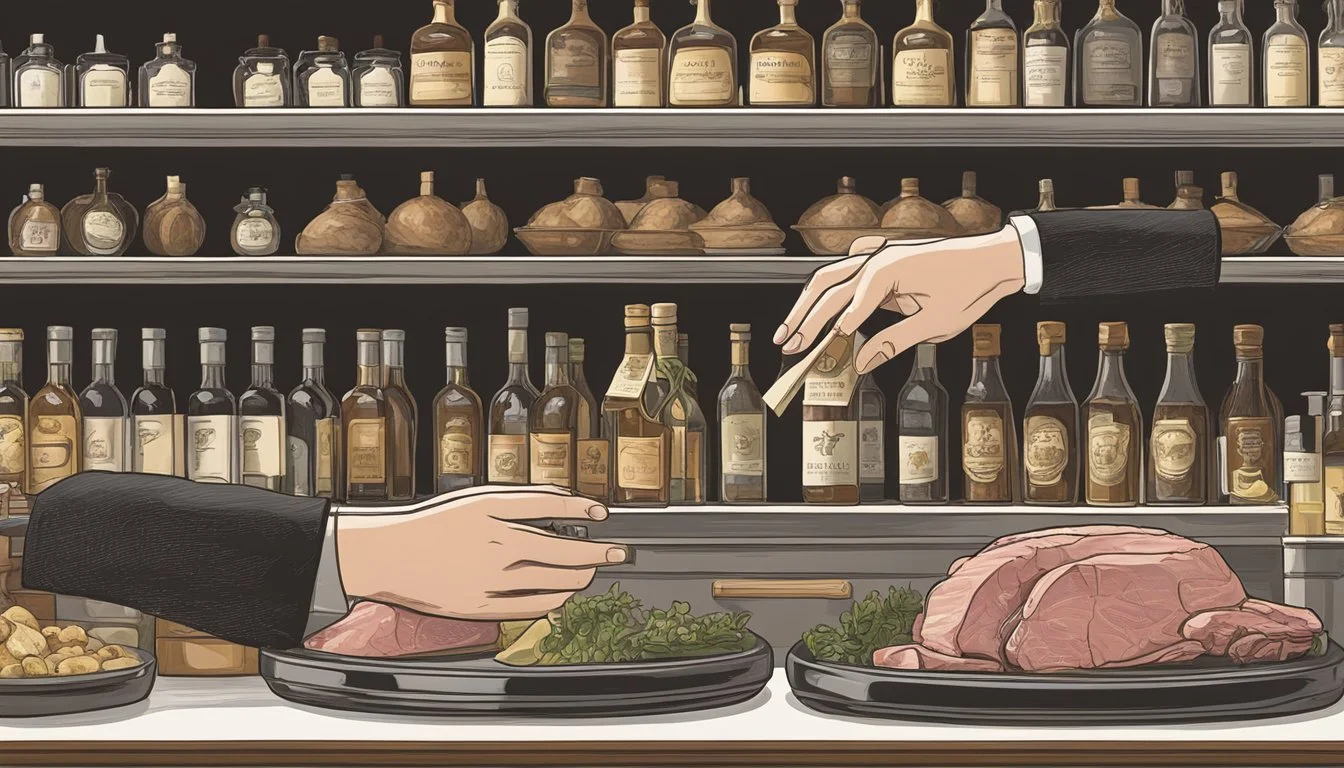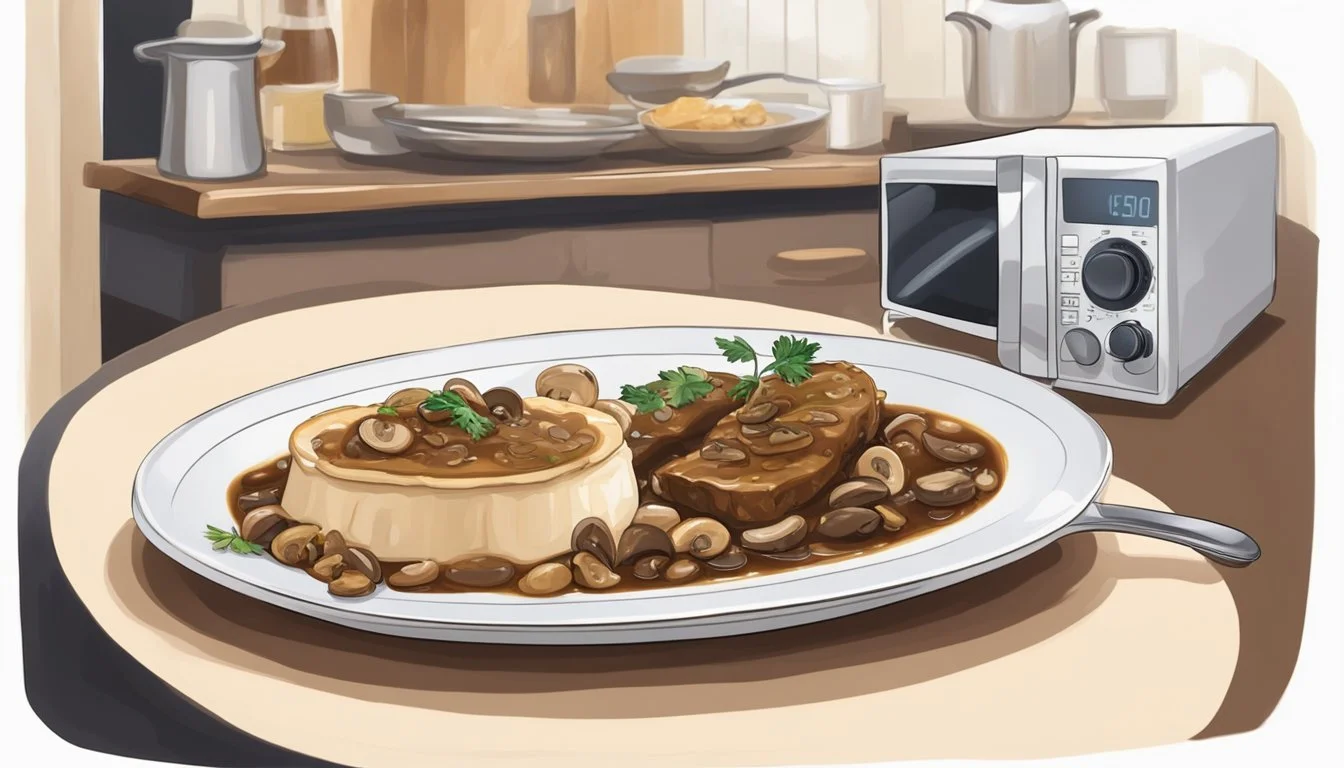How do you eat Veal Marsala?
A Guide to Enjoying this Classic Dish
Veal Marsala is a classic Italian-American dish that combines tender veal cutlets (What wine goes well with veal cutlets?) with a rich and savory Marsala wine sauce. It is a staple in many Italian restaurants and has made its way into the home kitchens of those who appreciate its delicate balance of flavors. The veal, usually pounded thin, is lightly floured and browned in a pan, then removed to make way for a sauce with an aromatic base of garlic and mushrooms (What wine goes well with mushrooms?), enriched by the addition of Marsala wine.
Eating Veal Marsala is an experience that goes beyond simply consuming a meal; it is about savoring the layers of taste that the dish offers. After the sauce reduces and thickens, infusing the sautéed ingredients with the sweet complexity of the Marsala, the veal cutlets are reintroduced to the pan to warm through and absorb the flavors of the sauce. Parsley is often sprinkled on top to add freshness and completes the dish with a herbal note.
On the table, Veal Marsala is typically served with a side that complements its rich sauce without overpowering the main. Choices such as creamy polenta, buttered noodles, or a simple risotto are popular, as they provide a subtle backdrop to the robust sauce. A vegetable side dish, often a simple steamed or sautéed green like spinach or asparagus, offers a counterbalance to the dish's richness and completes the meal with a touch of brightness and color.
Understanding Veal Marsala
Veal Marsala is a sophisticated yet comforting dish that perfectly embodies the Italian-American culinary tradition. At its core, it features tender veal escalopes that are lightly floured and sautéed to a golden hue. The dish is known for its rich and flavorful sauce made with Marsala wine, a fortified wine originating from Sicily, which imparts a unique taste and is integral to the dish's authenticity.
Key Components:
Veal: The main protein of the dish, traditionally thin slices that cook quickly.
Marsala Wine: A fortified wine from Sicily that adds a caramelized, nutty flavor to the sauce.
Mushrooms: Often included for their savory, earthy notes that complement the veal.
Garlic and Shallots: These aromatics are sautéed to build the foundational flavors of the sauce.
This dish represents a luxurious merger of Italian gastronomy with local American influences. The veal is typically browned in olive oil, and sometimes butter, to introduce a depth of flavor before being removed from the pan. The same pan is then used to sauté aromatics like garlic and shallots, along with mushrooms, which are essential to the dish's rich texture and umami flavor profile.
Once these ingredients meld, the Marsala wine is poured in to deglaze the pan, ensuring all the caramelized bits are incorporated into the sauce. This cooking method not only maximizes flavor but also showcases a technique cherished in Italian cooking. The sauce is then reduced to intensify the Marsala's characteristic flavors until it reaches the desired consistency, often finished with a touch of butter to create a smooth, velvety finish.
Veal Marsala's elegance and taste have secured its status as a cherished dish beyond Italy's borders, embraced heartily in American cuisine.
Selecting Ingredients
The foundation of a great Veal Marsala lies in selecting top-notch ingredients. This section guides you on how to choose the right cuts of veal, identify a quality Marsala wine, and gather the essential supporting ingredients to ensure the dish is authentic and flavorful.
Choosing the Right Veal
Select veal cutlets that are pale pink in color with a firm texture. They should be evenly sliced to about 1/4-inch thickness to ensure even cooking. Veal chosen for Marsala should be tender, so typically, cutlets from the leg or shoulder are preferred.
Identifying Quality Marsala Wine
Marsala wine, the namesake of this dish, should be of high quality; a wine that is good enough to drink. Opt for a dry or semi-dry variety for cooking to impart the right balance of nuttiness and sweet caramelization without overpowering the dish.
Type Characteristics Uses Dry Marsala Less sweet, used for savory dishes like Veal Marsala Cooking Semi-Dry Marsala Slightly sweet, versatile for both sweet and savory dishes Cooking
Essential Supporting Ingredients
The supporting cast of ingredients should include:
Mushrooms: Look for firm, fresh mushrooms with a smooth appearance. Button or cremini varieties work well.
Butter and Olive Oil: A combination of butter and olive oil provides a flavorful base for sautéing.
Garlic: Fresh, aromatic garlic should be used to infuse the dish with its signature flavor.
Flour: A light dusting of flour on the veal cutlets will aid in thickening the Marsala sauce.
Parsley: Choose fresh parsley for garnishing, offering a burst of color and freshness.
Salt and Pepper: Freshly ground black pepper and fine salt are fundamental for seasoning.
Veal Marsala Recipe
Creating a delicious Veal Marsala involves a series of methodical steps, from preparing the veal correctly to adding the perfect finishing touches. Embrace the art of cooking this classic dish with a focus on precision and flavor enhancement.
Basic Steps of Preparation
Start by selecting tender cuts of veal, preferably thin slices that are easier to cook through. The veal should be patted dry before seasoning with salt and pepper. Heating olive oil in a skillet until medium-hot, one must sear the veal for about 2 minutes per side or until a golden crust forms. Achieving the correct internal temperature is crucial, and using a meat thermometer can help ensure the veal is cooked to a safe 145°F (63°C). After searing, the veal should be transferred to a plate and kept warm.
Expert Cooking Techniques
Following the searing of the veal, one should sauté finely chopped shallot in the same pan, utilizing the flavors left behind. Once the shallots become translucent, add unsalted butter and let it melt, then introduce sliced mushrooms and cook them until they release their moisture and start to brown. At this stage, pour in Marsala wine to deglaze the pan, scraping up any browned bits. Allow the wine to simmer and reduce by half before pouring in chicken stock or heavy cream, depending on the desired richness of the sauce. Simmer until the sauce coats the back of a spoon, which signifies it's starting to thicken.
Final Touches and Plating
Return the seared veal to the pan, bathing it in the Marsala sauce to absorb the flavors and confirm it’s heated through. For a brighter taste, one might garnish with freshly chopped parsley or a squeeze of lemon juice just before serving. Veal Marsala should be plated with a generous spoonful of the mushroom Marsala sauce over the top, enhancing both its flavor and visual appeal. Serve alongside a starch or a green vegetable to balance the richness of the dish.
Serving Recommendations
When presenting veal marsala, complementing the richness of the dish with appropriately chosen side dishes and wine enhances the dining experience. Thoughtful pairings bring balance to the meal, allowing the flavors of the veal and sauce to shine.
Suggested Side Dishes
For a harmonious meal, offering a starch and a vegetable side dish often provides a well-rounded plate. The following suggestions can serve as a guide:
Starches:
Creamy Polenta: Its soft texture contrasts nicely with the tenderness of the veal.
Pasta: Opt for lighter shapes like egg noodles or pappardelle.
Risotto: A classic Italian choice, offering a creamy counterpart to the dish.
Mashed Potatoes: Simple and classic, they absorb the Marsala sauce beautifully.
Vegetables:
Green Beans: Steamed or sautéed, they add a fresh, crunchy element.
Roasted Vegetables: Seasoned with herbs like rosemary, as indicated in the search results.
Wine Pairing
Selecting the right wine to pair with veal marsala involves matching the weight and flavor profile of the dish. With the rich and savory notes of the Marsala sauce, wines that complement without overwhelming are ideal:
White Wines: Full-bodied whites such as Chardonnay or Viognier can balance the dish.
Red Wines: Lighter reds like Pinot Noir or Barbera offer a pleasing contrast without overpowering the subtle flavors of the veal.
Advanced Tips and Variations
Perfecting the art of creating veal Marsala involves nuanced techniques and the willingness to explore a range of flavors and ingredients. The following tips and variations can elevate this classic dish to a new level of culinary delight.
Handling Different Cuts of Meat
When preparing veal Marsala, it is essential to select the right cut of meat. The traditional choice is veal scallops (What wine goes well with scallops?) or scaloppine, which are known for their tenderness and thinness. To ensure even cooking and delicate texture, meat should be pounded to an even thickness before browning. For those seeking alternative options, pork, chicken, steak, or turkey can be suitable substitutes, as long as the pieces are sliced thinly to mimic veal scallops.
Exploring Marsala Substitutes
The Marsala wine is a defining component of this dish, offering a rich and nuanced flavor profile. While sweet Marsala is the classic choice, variations can include substituting with dry Marsala or even sherry for a different taste. When substituting, be mindful of the change in sweetness and adjust other seasonings accordingly to maintain a balanced flavor.
Creative Flavor Enhancements
Veal Marsala's sauce provides a canvas for creative additions that can enhance the overall dish. A pinch of black pepper can introduce a subtle heat, while herbs like rosemary, thyme, and oregano contribute to the aromatic complexity. For a final touch, a sprinkle of fresh parsley adds both color and a refreshing flavor contrast. Experimenting with these enhancements should be done with a light hand to ensure that the delicate veal flavor remains the star of the dish.
Storing and Reheating Veal Marsala
Proper storage and reheating techniques ensure that veal marsala retains its flavor and texture. Handling leftovers appropriately can also provide a convenient meal option for busy weeknights.
Best Practices for Refrigeration
Shelf Life: Ideally, veal marsala should be consumed within three days when stored in the fridge.
Temperature: Keep the refrigerator at or below 40°F to ensure food safety.
Airtight Containers: Store veal marsala in airtight containers to prevent contamination and preserve moisture.
Effective Reheating Methods
Stovetop Reheating:
Gently reheat veal marsala over low-to-medium heat.
Stir occasionally to ensure even warming without overcooking the meat.
Microwave Reheating:
Use a microwave-safe container and cover it with a microwave-safe lid or wrap to maintain moisture.
Reheat in short intervals, stirring in between to distribute heat evenly.
Freezing and Defrosting Tips
Freeze: Veal marsala can be frozen for up to 3 months. Before freezing, cool the dish completely.
Packaging: Use freezer bags or airtight containers to prevent freezer burn.
Defrost: Thaw veal marsala in the fridge overnight. Avoid defrosting at room temperature to reduce the risk of bacterial growth.
Reheating After Freezing:
Thoroughly defrost before reheating.
Follow the above reheating methods post-defrost to ensure quality and safety.
Food Safety and Handling
Ensuring food safety when preparing and consuming veal Marsala is paramount. Key factors include achieving proper internal temperatures and maintaining a hygienic cooking environment to prevent cross-contamination.
Proper Cooking Temperatures
Veal, the main component in veal Marsala, should be cooked to an internal temperature that is safe for consumption. The USDA recommends cooking veal to a minimum internal temperature of 145°F (63°C) and allowing it to rest for at least three minutes before serving. To accurately measure the internal temperature, one should use a meat thermometer inserted into the thickest part of the cut.
Safe Internal Temperature for Veal: 145°F (63°C)
Rest Time Post Cooking: 3 minutes
Avoiding Cross-Contamination
Maintaining kitchen hygiene is critical to prevent cross-contamination. Preparing veal Marsala involves handling raw meat, which can harbor bacteria that may contaminate other foods, utensils, or surfaces. To avoid this, cooks should:
Always wash hands before and after handling raw veal.
Use separate cutting boards for raw meat and other ingredients.
Clean all surfaces and utensils with hot, soapy water or a disinfectant after they come in contact with raw veal.
Never return cooked veal to the same plate or surface that held it when it was raw without cleaning it first.
By strictly adhering to these guidelines, one can reduce the risk of foodborne illness and enjoy veal Marsala safely.
Understanding Marsala Wine
Marsala wine is a fortified wine with a rich heritage, distinct taste, and culinary versatility across various Italian recipes, including the classic veal marsala.
History and Origin
Marsala, originating from Sicily, Italy, was first produced in the 18th century. Initially fortified to endure long sea voyages, its production has since evolved into a meticulous process, contributing to the wine's reputation. Marsala wine is typically aged in wooden casks and comes in dry and sweet varieties.
Taste Profile and Varieties
Marsala wine's flavor spectrum ranges from sweet to dry with alcohol content usually between 15% to 20%. Its taste is characterized by rich, toffee-like notes for sweet types and a more tannic profile for dry versions. Key varieties of Marsala include:
Fine: Aged for at least one year
Superiore: Aged for a minimum of two years
Superiore Riserva: A minimum of four years aging
Vergine: Aged for a minimum of five years
These variations allow chefs to choose the appropriate type based on the intended culinary uses.
Culinary Uses Beyond Veal Marsala
Marsala wine extends well beyond veal marsala. Its complex flavors enrich marsala wine sauce, employed in numerous Italian recipes such as chicken marsala (What wine goes well with chicken marsala?) and mushroom risotto (What wine goes well with mushroom risotto?). Whether used for deglazing or as a sauce base, the wine imparts depth and aroma synonymous with Sicilian cuisine.
Veal Marsala FAQs
In this section, readers will find answers to frequently asked questions and helpful tips for troubleshooting common issues encountered when preparing Veal Marsala.
Common Questions
What is Veal Marsala?
Veal Marsala is a classic Italian-American dish featuring thin slices of veal, mushrooms, and a rich sauce made with Marsala wine.What are the key ingredients in Veal Marsala?
The primary ingredients include veal cutlets, Marsala wine, mushrooms, garlic, and chicken stock.Are there variations of Veal Marsala?
Yes, chefs may incorporate different types of mushrooms, use shallots instead of garlic, or add cream for a richer sauce.What technique is essential for Veal Marsala?
A crucial technique is the reduction of Marsala wine to intensify the flavor and the proper browning of the veal for a golden exterior.
Troubleshooting Tips
Veal Overcooking:
To prevent overcooking, sear the veal cutlets quickly over medium heat and remove them from the pan while preparing the Marsala sauce.Sauce Not Thickening:
If the sauce is too thin, a slurry of flour mixed with water or chicken broth can be added to thicken it. Alternatively, simmer the sauce longer for natural reduction.Lack of Flavor:
Ensure a deep flavor by allowing the wine to reduce by at least half and by seasoning the veal generously with salt and pepper before cooking.
Related Italian Specialties
Veal Marsala's rich and savory flavors are echoed in other Italian dishes that have similarly become favorites in Italian restaurants and among home cooks specializing in Italian recipes.
Dishes Inspired by Veal Marsala
Veal Marsala has inspired a variety of dishes that showcase the finesse of Italian cuisine. Chicken Marsala is a well-known derivative, replacing veal with chicken and maintaining the essential Marsala wine sauce, which is pivotal to the dish’s character. Another variation is Pork Marsala, where pork cutlets are used instead of veal. These adaptations keep the spirit of the original dish alive while providing diners with different protein options.
Traditional Italian Courses
In traditional Italian courses, Veal Marsala often serves as a secondi or a second course after the primo, which might be a pasta or risotto dish. Complementing it are dishes like Osso Buco, braised veal shanks served with a complex, aromatic sauce and often accompanied by gremolata, a zesty herb condiment. Another classic is Scaloppine, thin cutlets of meat quickly sautéed; among its variations, Scaloppine al Marsala features the same beloved wine sauce as Veal Marsala, emphasizing the versatility of Marsala wine in Italian cooking.









